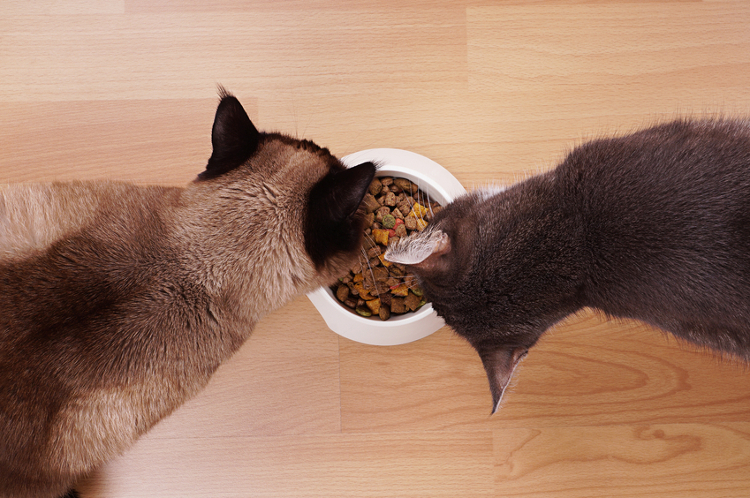When you walk into any pet mega-mart, you can feel completely overwhelmed with choices. Not only are there a confusing range of dry and wet cat foods, but there are also dozens of specific dietary recipes designed for each stage of a cat’s life. So how do you choose? Well, first and foremost, you should always ask your veterinarian what they recommend. That’s a no brainer. But if you have a young and healthy cat, chances are they will say most brands of cat food are fine. So then how DO you choose?
The Great Wet vs. Dry Battle
Back when I was a vet tech, most vets recommended dry food only because it helped keep cat’s teeth clean, and tartar buildup on cat’s teeth can lead to infections that can damage the kidneys. Today, however, the updated thinking is you should offer wet food as well because of the high water content — which actually helps the kidneys, of course. I will confess to being a very mean cat mom and choose to feed my own cats only dry because I utterly DESPISE the smell of wet cat food (although I do give it to them at Christmas). Again, check with your vet to see what works for you and your cat, but it does seem that a balance of wet/dry is ideal (such as wet once a day, and dry food left out all the time).
What is “Healthy” Cat Food?
The vast numbers of organic, low ingredient, and even vegan cat food is astonishing — and can cost two to three times more than the standard brands. So how do you pick? First, let me tell you my pet peeve about vegan cat food. Look, cats are hunters. They are the truest carnivore animal species, and in fact, their brains need specifically meat-based nutritional elements. So, in my opinion (and that of my vet), vegan food for cats is actually cruel. All that said, avoid carb-heavy recipes, especially those with high amounts of corn or soy products and look for brands that list meat as one of the first ingredients. Another tip is to look for cat foods that bear the seal of the Association of American Feed Control Officials (AAFCO).
What about Age-Appropriate Foods?
Yes, kittens need a different diet than cranky old cats (okay, maybe just my cats are cranky). Not only is kitten food better for little ones, the actual kibble is smaller and easier to chew — and wet food is denser with more protein for growth. So if you’re buying for a young cat, look for age-appropriate foods right in the nutrients cats need to grow. Older cats may also require some special diets, and chances are your veterinarian will prescribe something specific related to your cat’s issues.
Of course your adorable chubby kitties may do best on a “light” cat food — but be prepared for more frequent smelly litter bombs because they are packed with fiber. Lastly for older cats, you’ll swant to look for a high-protein, meat-based food that provides sufficient EPA/DHA (which provide relief for cats with arthritis or other joint diseases). Just please: don’t feed them vegan cat food.
What About Price?
You’ll find cat foods on both ends of the price scale—from bargain to gourmet. If your budget pushes you toward the bargain end of the spectrum, try to choose the brand with the highest real meat protein and the fewest carbs. Here’s how I’ve chosen my cat foods over the thirty years I’ve been a crazy cat lady: I find the one the cats like and doesn’t cause them to have mysterious and wet poop deposits in the pan. Then I stick with it and don’t change the diet, since frequent changes in diet can cause issues.
So right now my cats prefer a “natural” brand of one of the major pet food companies, but my last cats preferred a more high-end brand. If you want you can spend a great deal on cat food — heck, there are plenty of ways to even make your own if you’re so inclined although I can’t imagine why you’d bother with so many other options available.
These aren’t quite expert recommendations, but they do come from years of experience as a vet tech and being a cat owner. Hope this advice can help you out, and remember: cats aren’t vegan.






